By Louis J. Kern
Amidst the phenomenal spread of the messianic, millenarian Ghost Dance religion (1889-1890), responding to the murder of Sitting Bull, L. Frank Baum editorialized that “the best safety of the frontier settlements will be secured by the total annihilation of the few remaining Indians” (Saturday Pioneer, December 20, 1890), sentiments widely shared.
In the context of colonial subjugation, a Native prophet, Wovoka (Jack Wilson), adherent of the 1870 Ghost Dance, revealed a new spiritual dispensation to all Native peoples—a more comprehensive, syncretic Ghost Dance (1890). He predicted the imminent manifestation of a Messiah, resurrection of the dead, rejuvenation and freedom from disease, and the restoration of the world, with ancestors living alongside their descendants and the buffalo returning—a telluric, preterite paradise. Wovoka’s deontology exhorted followers to sobriety, to refrain from theft, deal honestly, keep the peace, love one another, and not “to refuse to work for the white man . . . or make any trouble with them . . . have your people work the ground . . . get farms . . . educate your children send them to schools.” The Ghost Dance did not, as whites feared, presage a pan-Indian uprising but was a Native theology combining traditional spiritualistic cultural forms and pragmatic strategies for adaptation to a modern agricultural/industrial America.
Justin Gage, working in the tradition of Subaltern Studies and Identity Politics, provides a reinterpretation of the Ghost Dance that emphasizes Native agency, resistance to federal confinement and territorial engrossment, and forced assimilation. Native Americans created newspapers in their own languages and, as English literacy expanded, increasingly read white newspapers, using them to communicate their concerns. Ironically, the U.S. program of assimilation and suppression became a tool of resistance to colonial repression and genocide.
Gage offers a history of decolonization and resistance grounded in extensive archival research. The defiant insistence on Native off-reservation mobility and inter-tribal meetings to learn about Ghost Dance revelations and to maintain kinship networks was a major conduit of information and inter-tribal organization. Natives maintained an extensive epistolary correspondence that relied heavily on the postal service and later the telegraph. They travelled extensively, often by railroads that provided free transit, making pilgrimages to massive Ghost Dance ceremonies and using the rails to transport goods to centers of the market economy.
Government failure to keep Natives on reservations, despite their dependency on government rations, ironically promoted the very assimilation Indian agents desired. The Ghost Dance augmented Native unity and elicited demands for jobs, money, and religious freedom. Jack Wilson worked as a farm hand in California and appeared in the film The Thundering Herd (1924). He had been preceded by Native actors in The Covered Wagon (1923) and the all-Indian cast of Daughters of the Dawn (1919). Wilson also embodied evangelical marketing, at times claiming to be the resurrected Messiah and selling his used hats and clothes as relics. As a reformer he crusaded against opium and alcohol abuse.
The Ghost Dance did not die with Wounded Knee (1890), but persisted into the twentieth century as an expression of Native identity, empowerment, and ethical guidance, topically revived in 1973 and 2006. But discrimination endured—Native Americans became U.S. citizens only in 1924, could not vote until 1962, and their spiritual claims were only recognized by the American Indian Religious Freedom Act (1978) and the legalization of the Native American Church (peyote rite, 1993). Perhaps the cycle envisioned by Crazy Horse—“upon suffering beyond suffering the Red Nation shall rise again, and it shall be a blessing for a sick world” (1890)—will enable the redemption of this tragic and unconscionable chapter of our national history.
Louis J. Kern (ΦBK, Clark University) is professor emeritus of history at Hofstra University. Hofstra University is home to the Omega of New York chapter of Phi Beta Kappa.




